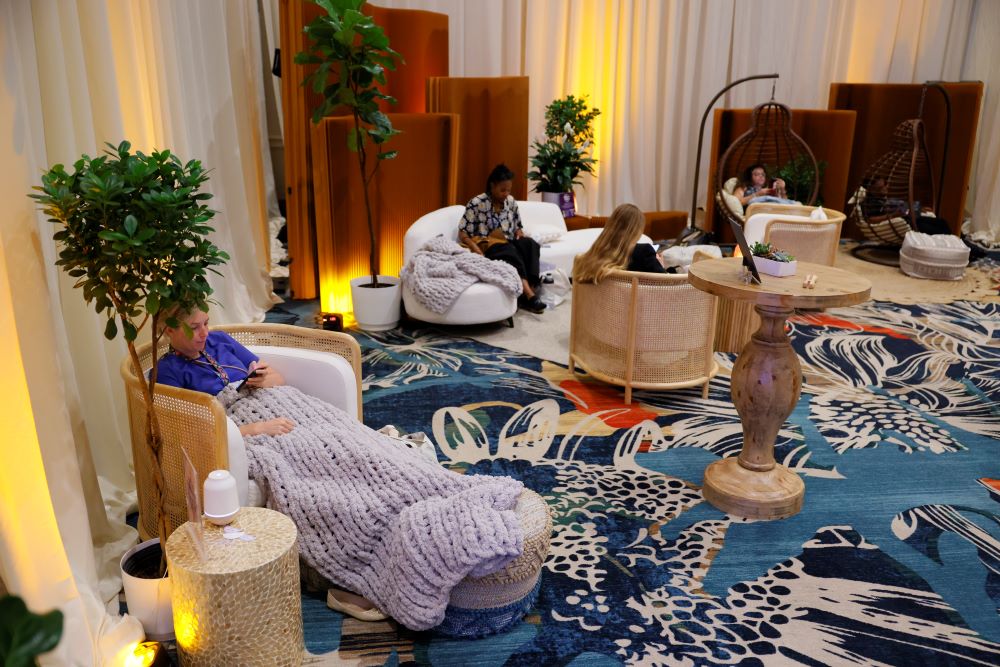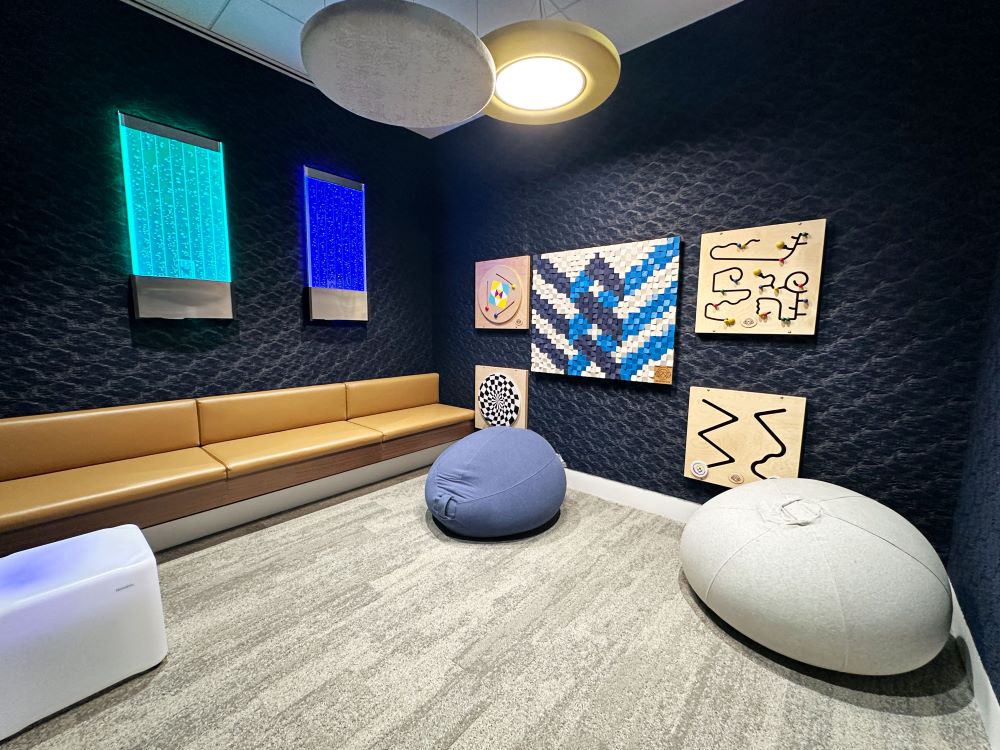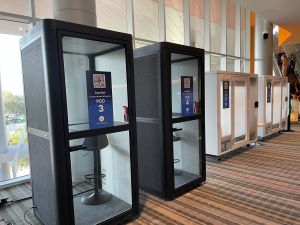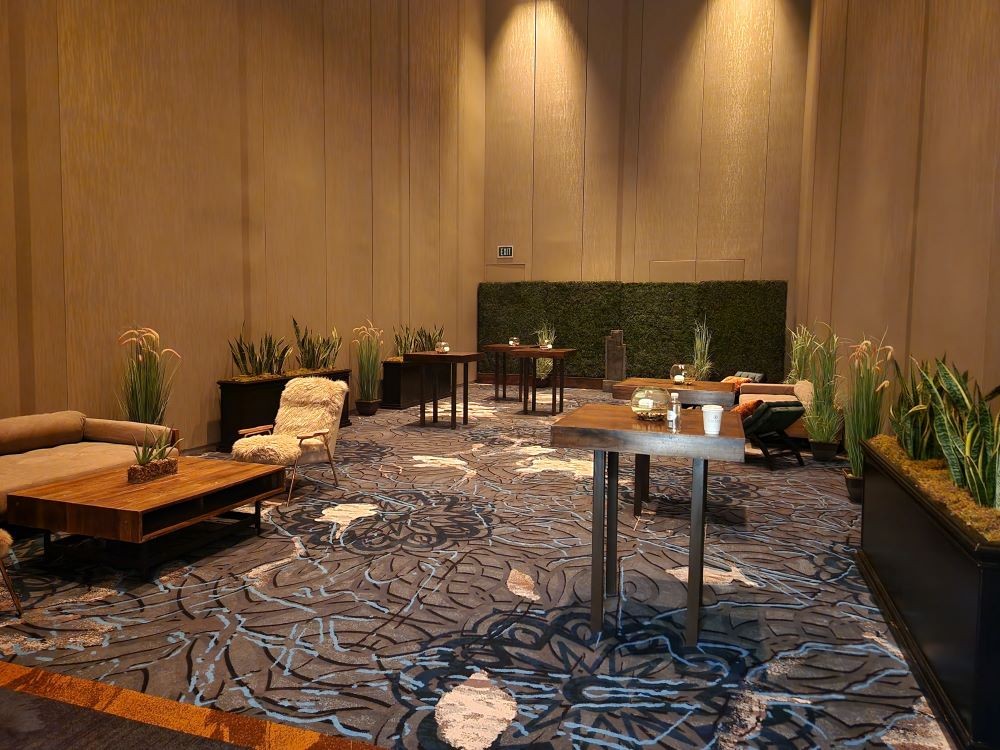If you’ve been to a meeting or conference lately, you might have noticed an unfamiliar room or booth on the convention floor. The room might be dimly lit, have soundproof curtains and/or people lying down wearing headphones. Despite the chaos and frantic nature of the conference, everyone in this room seems calm, maybe even sleeping? OK, what the heck is going on here?
You’ve just discovered a “quiet room.”
Here’s everything you need to know about quiet rooms: why they’re popping up everywhere, what their purpose is and why you should have one at your next event.
What Are Quiet Rooms?
These tranquil spaces are not secret spas in the middle of a busy show floor but instead are known as “quiet rooms” (also called sensory rooms or low-sensory rooms). These quiet or sensory rooms serve as places for people who are overwhelmed or overstimulated to regulate themselves before heading back out onto the event floor.

People who utilize these rooms might have a neurological disorder, such as autism or Asperger’s, but others who utilize the space might just be searching for a low-sensory or calm area to collect their thoughts or get away from the hustle and bustle of a busy event. No matter what the reason for needing them might be, quiet rooms have the ability to benefit everyone at an event, with many attendees even requiring them to feel comfortable or safe attending an event in the first place.
While there are few studies that have been done into the specific benefits of quiet rooms for neurotypical individuals, some research suggests quiet spaces can help improve concentration, memory retention, comprehension and a general “recharging” of one’s social battery.
Benefits of Quiet Rooms

While quiet rooms might especially help those who are neurodivergent navigate events easier, they can also provide many benefits to neurotypical attendees.
Stephen Cutchins, senior manager of accessibility at Cvent, explained that many accessibility accommodations will also provide benefits to everyone through the curb-cut effect, where designs and accommodations intended to benefit a specific group, oftentimes those with disabilities, can also benefit a larger population. Quiet and sensory rooms can also have this effect, where no matter the reason people might need to utilize them, they will still receive a benefit from having them at the event.
“That reason could be, ‘Conferences are overwhelming for me because I have a neurological disorder,’ or it could be, ‘My gosh, I need a minute, I just need to get away and collect my thoughts,’ and that’s what [quiet rooms] are for,” Cutchins said.
Tahira Endean, head of program at IMEX, says their show has also been incorporating quiet rooms for years.
“You can’t be overwhelmed and want to connect with people. Those two just don’t go together,” Endean said. “Everything I do is focused on humans coming to events, and humans are not designed to go at Mach 1 from the minute they wake up until the minute they go to bed. So, I would actually say that having a quiet room at your conference is just good business.”

Endean says one of the main benefits of having quiet rooms at a show like IMEX is that it also offers a space for international attendees to rest during the conference and regulate their circadian rhythm. Many of IMEX’s attendees can be on a completely opposite sleep cycle depending on how far they traveled to where the show is taking place, so offering a place where people can rest (or yes, even sleep) during the event can provide enormous upsides for those attendees coming from far away.
“We ask people to do long days during events,” Endean said. “They start at 7 or 8 in the morning and they’re still partying at midnight and it’s hard, right? So, to be able to have space to reset I think is really, really important for people.”
Incorporating Quiet or Sensory Rooms
Both IMEX and Cvent have incorporated quiet and sensory rooms in a variety of ways at their events. At IMEX America 2024, the organizers partnered with Google’s Neu Project and Hello DMC to create the Resilience Space, which provided tools and resources to manage fatigue and sensory needs at the event.
IMEX also introduced a quiet space in 2023, which the group plans to build on at this year’s IMEX event by including breathwork and meditation sessions at various points throughout the show.
Cvent offered a low sensory room at its 2023 CONNECT event in Las Vegas that included dim lighting, electronic candles, soft seating, white noise and a “no phones” and “no talking” policy. At Cvent’s most recent event in San Antonio, they brought in private booths with frosted glass that served as both a place for people to make phone calls during the event and also a quiet space for them to decompress and relax.
Milwaukee’s Baird Center also incorporated sensory rooms into the convention center’s recent upgrades. Working with KultureCity, a nonprofit organization that helps venues create sensory-inclusive modifications, Baird Center created two sensory rooms as part of its $456 million expansion in 2024, allowing guests with sensory needs to have a safe, comfortable and controlled environment in which to decompress.

“Baird Center often hosts events that contain a lot of stimuli, ranging from gaming conventions to youth sports tournaments, so it was critical to have places that offered an escape for people who were being overstimulated,” said Joe Scialfa, director of communications for Baird Center. “One of the goals of the [renovation] project was to ensure every visitor to Baird Center was made to feel safe, welcome and respected.”
Start Simple

Even for convention centers or planners who don’t have access to a multimillion-dollar renovation budget, quiet rooms can still easily be incorporated into an event. Cutchins and Endean both agree that even quiet or sensory rooms that are simple and low-cost can provide valuable benefits to attendees.
“You don’t need it to be fancy to be effective,” Endean said. “Sometimes planners are like, ‘Oh, I can’t possibly give up a room.’ You don’t need to have a giant space, you could use one of the smaller breakout rooms. It doesn’t even need to be staffed!”
Cutchins said planners can start with something like a “no phone zone” that just gets people off of their electronics and into a quiet or secluded space, even if the execution of it isn’t perfect. The concept could be simple, but having something simple versus having nothing at all could mean the difference between someone attending or not attending your event.
“It’s way better to try and not be perfect than not try at all,” Cutchins added.
Read this next: 4 Ways to Accommodate Attendees With Disabilities at Events







